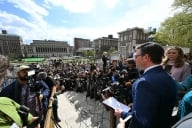You have /5 articles left.
Sign up for a free account or log in.
“This is the official source for U.S. visa information…”
“Your credit card will be charged $14. You’ll have immediate access to the service once your transaction has been approved.”
Chileans pay $14 total; in South Africa, expect to pay the equivalent of $11 for nine minutes of talk time. Citizens of Hong Kong and Macau fork over 10 Hong Kong dollars, or $1.28, a minute, and Italians 1.5 Euro ($2.36) for each 60-second cycle.
Brazilians by contrast pay a flat rate: 38 real, or about $23. In Japan, even sending an e-mail inquiring about the visa process costs money: 2129.43 yen, or about 20 bucks. ("Once we have responded to your inquiry we will not respond to any additional follow-up questions unless you pay for another email inquiry.")
A recent University of California at Los Angeles survey of perceptions of international students and scholars studying in the United States recorded a number of complaints from individuals disconcerted with the costs of calling toll hotlines to obtain U.S. nonimmigrant visa application information – and book required interview appointments at the consulate. “It is unjustified to pay 50 bucks in phone costs to call a call-center to get an appointment, I strongly disagree on these hidden fees,” one Swiss H-1B scholar wrote in response to the 2007 survey of 1,570 international students and scholars at UCLA.
Although there’s lots of concern among international student administrators over proposed increases in fees for nonimmigrant visas, students and scholars often are accepting of set fees and vehement about this more minor matter (monetarily speaking) of paying the phone bill, explained Shideh Hanassab, who conducted the study and is director of research for UCLA’s international office and director of J scholar and student services. “They apply for a visa, OK…they charge you,” that’s accepted, she said – “but not when you’re calling and they put you on hold.”
“It’s just annoying but when you’ve got somebody that’s pretty anxious about visa acquisition anyway, any little annoyance is going to put them over the edge," said Marjory Gooding, director of International Offices at California Institute of Technology.
“It’s those nickel and dime things that really get people sort of cranky.”
A U.S. State Department official explained that the agency maintains two umbrella contracts with outside companies that operate consulates’ call-centers – the mechanism for offering customer service and scheduling interviews mostly at high-traffic, high-profile consulates (representing fewer than 70 of the United States’ 220 posts). The companies set fees that reflect in-country conditions in consultation with the consulate, the official explained. The State Department, which is required by law to recover costs associated with nonimmigrant visa processing through fees, moved to the toll model to more efficiently respond to high demand in the 1990s.
“We found that this is a better way to give our customers the kind of service information that they want and need,” the official said. “This helps us reduce waits for people calling. It also provides a number of lines that are available so customers aren’t frustrated by trying to call a consulate only to not get through on a switchboard.”
“One of the great side benefits here is that we are able to identify students when they are applying and to route them into any priority interviewing tracks” if they have an urgent meeting abroad or a semester of study is about to start, the official continued.
“That improvement in service has a monetary value.”
Australia, meanwhile, operates a toll-free Ottawa-based line (1-888) and free e-mail inquiry service for visa applicants from the Americas. A spokeswoman for Citizenship and Immigration Canada said she knew of no comparable toll lines at Canadian posts abroad, but that applicants do have a call-center they can phone from inside the country.
It’s free.






